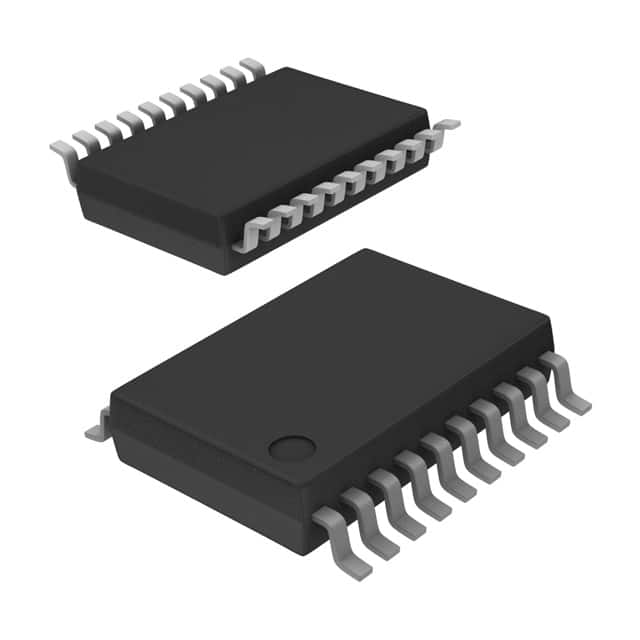Viz Specifikace pro podrobnosti o produktu.

ADS1255IDBT
Product Overview
Category: Integrated Circuit (IC)
Use: Analog-to-Digital Converter (ADC)
Characteristics: - High-resolution ADC - Low power consumption - Small package size - Wide input voltage range - Serial interface compatibility
Package: DBT (SSOP-28)
Essence: The ADS1255IDBT is a high-resolution, low-power analog-to-digital converter designed for various applications that require precise and accurate conversion of analog signals into digital data.
Packaging/Quantity: The ADS1255IDBT is available in a SSOP-28 package and is typically sold in reels or tubes containing multiple units.
Specifications
- Resolution: 24 bits
- Input Voltage Range: ±Vref
- Sampling Rate: Up to 30 kSPS (Samples per Second)
- Power Supply Voltage: 2.7V to 5.25V
- Operating Temperature Range: -40°C to +85°C
Pin Configuration
The ADS1255IDBT has a total of 28 pins, which are assigned specific functions. Here is the detailed pin configuration:
- AVDD: Analog Power Supply
- DVDD: Digital Power Supply
- AGND: Analog Ground
- DGND: Digital Ground
- REFOUT: Reference Output
- REFIN1(+): Positive Reference Input
- REFIN1(-): Negative Reference Input
- REFIN2(+): Positive Reference Input
- REFIN2(-): Negative Reference Input
- AIN0: Analog Input Channel 0
- AIN1: Analog Input Channel 1
- AIN2: Analog Input Channel 2
- AIN3: Analog Input Channel 3
- AIN4: Analog Input Channel 4
- AIN5: Analog Input Channel 5
- AIN6: Analog Input Channel 6
- AIN7: Analog Input Channel 7
- DRDY: Data Ready Output
- CS: Chip Select Input
- SCLK: Serial Clock Input
- DIN: Serial Data Input
- DOUT: Serial Data Output
- PWDN: Power-Down Input
- RESET: Reset Input
- TEST: Test Mode Input
- NC: No Connection
- NC: No Connection
- NC: No Connection
Functional Features
- High-resolution conversion: The ADS1255IDBT offers a resolution of 24 bits, allowing for precise and accurate analog-to-digital conversion.
- Low power consumption: With its low power design, the ADC minimizes energy consumption, making it suitable for battery-powered applications.
- Serial interface compatibility: The device supports various serial interfaces, including SPI (Serial Peripheral Interface) and QSPI (Quad Serial Peripheral Interface), enabling easy integration with microcontrollers and other digital systems.
- Programmable gain amplifier: The built-in programmable gain amplifier allows for amplification of weak analog signals, enhancing the overall sensitivity of the ADC.
Advantages and Disadvantages
Advantages: - High resolution ensures accurate conversion of analog signals. - Low power consumption extends battery life in portable devices. - Small package size enables space-efficient designs. - Wide input voltage range accommodates various signal levels. - Serial interface compatibility simplifies integration with digital systems.
Disadvantages: - Limited sampling rate compared to some higher-end ADCs. - May require additional external components for specific applications. - Higher cost compared to lower-resolution ADCs.
Working Principles
The ADS1255IDBT operates on the principle of successive approximation, where the analog input signal is compared to a reference voltage and converted into a digital representation. The device utilizes an internal programmable gain amplifier to amplify the input signal before conversion, allowing for precise measurement of small analog signals. The converted digital data is then transmitted through the serial interface for further processing or storage.
Detailed Application Field Plans
The ADS1255IDBT finds applications in various fields that require high-resolution analog-to-digital conversion. Some potential application areas include:
- Industrial Automation: Precise measurement and control systems.
- Medical Equipment: Biomedical signal acquisition and analysis.
- Test and Measurement: High-accuracy data acquisition systems.
- Energy Monitoring: Power metering and energy management systems.
- Scientific Research: Data collection and analysis in research experiments.
Detailed and Complete Alternative Models
- ADS1256IDBT: Similar to ADS1255IDBT but with higher sampling rate (up to 30 kSPS).
- ADS1248IPWR: 24-bit ADC with integrated PGA and multiplexer.
- MCP3424E/SL: Low-power, 18-bit ADC with I2C interface.
- MAX111
Seznam 10 běžných otázek a odpovědí souvisejících s aplikací ADS1255IDBT v technických řešeních
Sure! Here are 10 common questions and answers related to the application of ADS1255IDBT in technical solutions:
Q: What is the ADS1255IDBT? A: The ADS1255IDBT is a high-precision, low-power analog-to-digital converter (ADC) designed for applications that require accurate measurement of small signals.
Q: What is the resolution of the ADS1255IDBT? A: The ADS1255IDBT has a resolution of 24 bits, allowing it to provide precise measurements with high accuracy.
Q: What is the input voltage range of the ADS1255IDBT? A: The ADS1255IDBT has a programmable input voltage range, which can be set to ±2.5V, ±5V, or ±10V, depending on the application requirements.
Q: What is the maximum sampling rate of the ADS1255IDBT? A: The ADS1255IDBT can achieve a maximum sampling rate of up to 30,000 samples per second (SPS), enabling fast and real-time data acquisition.
Q: Can the ADS1255IDBT operate in a single-ended or differential mode? A: Yes, the ADS1255IDBT can operate in both single-ended and differential modes, providing flexibility in signal measurement configurations.
Q: Does the ADS1255IDBT have built-in digital filters? A: Yes, the ADS1255IDBT features a programmable digital filter, allowing users to optimize noise rejection and enhance signal quality.
Q: Is the ADS1255IDBT suitable for low-power applications? A: Yes, the ADS1255IDBT is designed for low-power operation, consuming minimal power during normal operation and offering power-saving modes.
Q: Can the ADS1255IDBT interface with microcontrollers or other digital devices? A: Yes, the ADS1255IDBT has a serial peripheral interface (SPI) that enables easy communication with microcontrollers and other digital devices.
Q: What are some typical applications of the ADS1255IDBT? A: The ADS1255IDBT is commonly used in applications such as precision weighing scales, data acquisition systems, medical instrumentation, and industrial automation.
Q: Are there any evaluation boards or development kits available for the ADS1255IDBT? A: Yes, Texas Instruments provides evaluation boards and development kits specifically designed for the ADS1255IDBT, making it easier to prototype and test solutions using this ADC.
Please note that these questions and answers are general and may vary depending on specific application requirements and implementation details.

